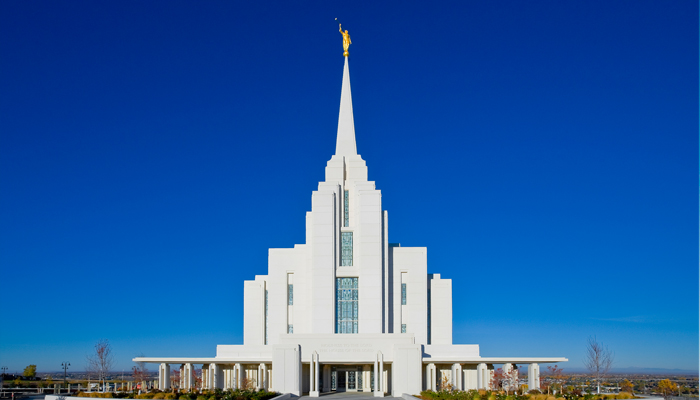
Former Temple President on How to Unlock the Power of the Temple
Title: The Temple—Gaining Knowledge and Power in the House of the Lord
by: Ed J. Pinegar
In review of Brother Pinegar’s 2014 book, another beautifully crafted work from his long list of published works, we acquire an in—depth look into how the Lord uses symbols, repetition, and all our senses to teach us how Christ is at the center of everything we experience and come to know about the temple.
By ‘feasting’, instead of just reading, on this rich dining experience and abundance of knowledge which Brother Pinegar shares with us,we can come away with a deeper appreciation and taste for the finer points of how we can enjoy our every visit to the temple.
Through study, prayer, and by paying close attention during our visits, we can receive personal understanding and revelation of this knowledge for ourselves; not only as patrons, but as a full participants and eternal co—inheritors with Christ of all that our Father in Heaven has.
His remarkable insight into the connection between the atonement and the temple ordinances and how it all centers in, around and through our Savior, Jesus Christ, has been gleaned through years of experience and study. As well as, of his personal participation in all aspects of temple attendance; as a patron, a worker and through service as a former President of the Manti Temple.
He shares with us a deep conviction of the process of learning, by experiencing the symbolism found within the repetitive yet precious rituals and ordinances by which we can all gain access to the blessings found through temple attendance. If we continuously strive to learn how to use all our senses during each and every visit, we grow line upon line, precept upon precept, and grace by grace.
We not only go for ourselves, but to perform, by service, the vicarious work we do for others, and with each act of service we grow and develop in gratitude by utilizing our ‘temple eyes, ears and hearts’. By seeing, hearing and feeling we begin to absorb all that the Lord would have us know, and with which we need to understand, to return and live with Him once again.
This book is not a sit-down and read from cover to cover quickly, kind of book. It requires and demands, as each chapter is consumed like a single and rich course within a meal, both thought and reflection. And as we develop a new appreciation and taste for the subtle flavors of each principle and bits of doctrine we find in each and every delicacy we taste, we discover that we want more; through study.
One taste is not enough. Each bite, or section within a chapter, must be thoroughly, deliberately savored, before we are able to digest and take the knowledge or nourishment we can gain by not only reading it, but by using this book, “the Temple”, as a study guide.
It is not only a meal, but a fully loaded buffet table of dishes (ideas, quotes, scriptures and thoughts). All of which are rich with satisfying promises and blessings and set before us to feast and gorge ourselves upon if we only partake of them; by reading and studying, meditating and praying, then by attending the temple often. Then, waiting patiently for the ‘Mysteries of Godliness’(or dessert) to be revealed to us in time.
It took longer than I had anticipated, to read through Brother Pinegar’s book, but I found new understanding and a deeper appreciation for and of the ‘infinite and eternal’ blessings that can be ours. My testimony has grown with the knowledge that we not only make the choice to be worthy to go to the ‘House of the Lord’; but choose to do so each and every day by how we live.
I came to know with greater conviction that we are abundantly and richly blessed for choosing to live each day in acceptance of the ‘gift’ of the atonement and by putting into practice what we learn by attending the temple frequently.
It has always been important to me, but never more so than during the last couple of years, as I have experienced the peace and understanding that has continued to come my way from within the walls of the Lord’s House, even as I struggled through trial after trial.
While sitting by my father’s bedside during his final days upon earth, and reading this book in what I thought was to be a simple assignment and book review, I have come to more fully appreciate the life he led. I have been blessed by the example he has set for me in the way he quietly, yet thoughtfully chose to live through deed and action, the principles taught within the temple walls.
I saw growing up, by his example, the many ways he put into his daily life, the practices of and the power found through the gift of the ‘endowment’, the ordinances, and the covenants he made there. His choices and actions have shown his firm belief in the atonement and in Christ.
As time grows near, when he will pass through the veil completely, he frequently speaks of with gratitude, the people and things of most importance in this life and in the life to come: family, friends, the gospel, the profound effect of both his mission and the influential example set by President Monson have had in his life.
Dad speaks of the eternal aspects of the temple, as he returns again and again, to walk through it’s rooms, even though only in his wandering mind. He not only reminds me, but shows me for the last time in his mortal life, the importance of Christ’s role in God’s Divine Plan of Salvation, as he speaks of returning ‘Home’, by way of ‘walking through it’s rooms to the ‘Veil’, he so longs to pass through.
I know this, because of the way he continues to bear the afflictions of his body and mind, and not lose the ‘core’ of who he was, and is, and chooses to be throughout —even until he leaves this life shortly. The timely assignment to review this book, has indeed been one of the Lord’s tender and merciful graces for me personally.
Brother Pinegar’s explanations of principles, and of how even the scriptures are imbued with the same doctrine we are taught within it’s walls, shows us time and again how the temple is a blessing given to us that we should never take for granted. He shows how the temple, with all it’s ordinances, is eternally entwined with the Savior’s gift of the atonement, as well as Christ himself, being God the Father’s only begotten son, here in mortality.
Through temple attendance and the learning we experience there, we can become more like Him. By showing our gratitude in everything that we do, every choice we make, and by every oath and covenant we accept, we are enabled by and through the priesthood power we are endowed with, to return to live with Him. Whether male or female, we share equally in the ‘sealing powers’ found in the temple.
This book is full of additional study helps, suggestions, references from other published sources, quotes from general authorities, as well as examples and direct teachings from scripture, as the’Word of God’, which we all have accessible and within our grasp to learn from. Brother Pinegar has put these things into perspective for us, in a unique way, unlike other great books written about the temple.
It contains real depth and insight, that gives the reader pause, in which to begin the process of learning that can only be found in the temple. In his introduction he encourages readers to study, ponder and pray to understand the mysteries of God that are taught in the temple.
He hopes that we can all embrace, through temple worship, the feelings and insights we find there, by experiencing and learning to recognize the ‘glory and presence of the Lord’. His book follows the pattern used in the processes of teaching found in the temple; that of repetition and learning line upon line and precept by precept.
In chapter one, he teaches us to understand and appreciate that all things typify or symbolize Christ, and center on His Infinite Atonement. By experiencing and focusing on the symbolism we learn, we come to see that they hold the keys to those ‘mysteries of the kingdom and to the knowledge of God’.
Discussion begins and continues throughout each chapter focusing on the eternal truths about the ‘Plan of Happiness’, learning about how the atonement and the endowment are inseparably connected, and how become justified and sanctified through the Holy Ghost and the Power of the Priesthood; all within the Lord’s House: the Temple.
To enter His House, we must be worthy. To partake and receive of His Spirit and Glory, we must prepare ourselves; body, mind and heart. It is through His Gift of Grace, and our acceptance of it, if we deny not His Power, that we are then empowered to our very souls—to do good works in His strength.
Through faith, prayer, diligence and obedience, and frequent temple attendance we open ourselves to receiving revelation which comes to us through the Power of the Holy Ghost. God communicates to us through the symbols of words, actions, objects and gestures. Even the myriad names of Christ represent differing aspects of His mission.
Temple Worship is our ‘sacrifice’ in today’s world, as was animal sacrifice in ancient times. Altars have always been built and used since the time of Adam, when he ‘called upon the Name of the Lord’. When we call upon the name of the Lord, confess His hand in all things, and express thanksgiving we have His promises and blessings and may access them by the Saviors Atonement through participation in the ‘Sacred Ordinances’ found within the Temple.
The Endowment is an enabling Gift of Power, given freely to the worthy, but accepted by covenant through the administration of the greater or Melchizedek Priesthood. It references virtue, or righteousness, purity and power or strength and with it’s blessing we are able to draw on the powers of Heaven to bless others.
Christ’s great Intercessory Prayer, found in John 17:1-23 helps us to understand the ‘oneness’ we need to develop and which Christ prayed for on our behalf. Since we have a need to become ‘perfected’ through Christ, and gain eternal life, we begin to understand the need for temples and the work we do in them. Performing the saving ordinances for our kindred dead, magnifies and fully manifests the Lord’s words when he says; “This is my work and my glory—to bring to pass the immortality and eternal life of man'(Moses 1:39).
Eternal families and the Sealing Powers administered by the Lord’s agents, who hold the proper priesthood keys on earth, and the ‘Gathering’ in these latter—days are all part of the ‘Plan of Redemption’. It is our charge and duty, in this final dispensation, to do this work vicariously for our dead, who cannot do it for themselves. In this we become partners and co-inheritors with Christ of all the Father has, because He, through His sacrifice for us, did what we could not do for ourselves.
The Temple is the truest model of teaching and learning in this life. Adam and Eve were the first examples. All the doctrines we need are taught in the scriptures, and it is in the temple where we come to understand them.
If we are willing to receive, accept and act upon those things we learn, we are then granted through our obedience and worthiness, the unrestrained presence and glory of God. It is through Temple Worship, though frequently an inconvenient sacrifice on our part to go, where we gain His Grace, clothe ourselves with Charity, take upon us His Name, and enter into His Rest. The Temple is the only way to return to God through Jesus Christ.
Only a few ‘morsels’ and highlights found in Brother Pinegar’s book have been shared here, but if read and ‘relished’, deliberately studied and’devoured’, the reader will come away from this ‘feast’ infinitely, eternally, and satisfyingly ‘filled’!









